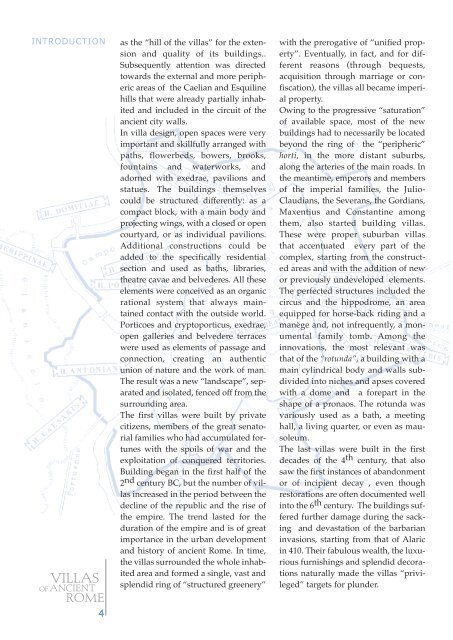You also want an ePaper? Increase the reach of your titles
YUMPU automatically turns print PDFs into web optimized ePapers that Google loves.
INTRODUCTION<br />
VILLAS<br />
OF ANCIENT<br />
ROME<br />
4<br />
as the “hill <strong>of</strong> the villas” for the extension<br />
and quality <strong>of</strong> its buildings..<br />
Subsequently attention was directed<br />
towards the external and more peripheric<br />
areas <strong>of</strong> the Caelian and Esquiline<br />
hills that were already partially inhabited<br />
and included in the circuit <strong>of</strong> the<br />
ancient city walls.<br />
In villa design, open spaces were very<br />
important and skillfully arranged with<br />
paths, flowerbeds, bowers, brooks,<br />
fountains and waterworks, and<br />
adorned with exedrae, pavilions and<br />
statues. The buildings themselves<br />
could be structured differently: as a<br />
compact block, with a main body and<br />
projecting wings, with a closed or open<br />
courtyard, or as individual pavilions.<br />
Additional constructions could be<br />
added to the specifically residential<br />
section and used as baths, libraries,<br />
theatre cavae and belvederes. All these<br />
elements were conceived as an organic<br />
rational system that always maintained<br />
contact with the outside world.<br />
Porticoes and cryptoporticus, exedrae,<br />
open galleries and belvedere terraces<br />
were used as elements <strong>of</strong> passage and<br />
connection, creating an authentic<br />
union <strong>of</strong> nature and the work <strong>of</strong> man.<br />
The result was a new “landscape”, separated<br />
and isolated, fenced <strong>of</strong>f from the<br />
surrounding area.<br />
The first villas were built by private<br />
citizens, members <strong>of</strong> the great senatorial<br />
families who had accumulated fortunes<br />
with the spoils <strong>of</strong> war and the<br />
exploitation <strong>of</strong> conquered territories.<br />
Building began in the first half <strong>of</strong> the<br />
2 nd century BC, but the number <strong>of</strong> villas<br />
increased in the period between the<br />
decline <strong>of</strong> the republic and the rise <strong>of</strong><br />
the empire. The trend lasted for the<br />
duration <strong>of</strong> the empire and is <strong>of</strong> great<br />
importance in the urban development<br />
and history <strong>of</strong> ancient <strong>Rome</strong>. In time,<br />
the villas surrounded the whole inhabited<br />
area and formed a single, vast and<br />
splendid ring <strong>of</strong> “structured greenery”<br />
with the prerogative <strong>of</strong> “unified property”.<br />
Eventually, in fact, and for different<br />
reasons (through bequests,<br />
acquisition through marriage or confiscation),<br />
the villas all became imperial<br />
property.<br />
Owing to the progressive “saturation”<br />
<strong>of</strong> available space, most <strong>of</strong> the new<br />
buildings had to necessarily be located<br />
beyond the ring <strong>of</strong> the “peripheric”<br />
horti, in the more distant suburbs,<br />
along the arteries <strong>of</strong> the main roads. In<br />
the meantime, emperors and members<br />
<strong>of</strong> the imperial families, the Julio-<br />
Claudians, the Severans, the Gordians,<br />
Maxentius and Constantine among<br />
them, also started building villas.<br />
These were proper suburban villas<br />
that accentuated every part <strong>of</strong> the<br />
complex, starting from the constructed<br />
areas and with the addition <strong>of</strong> new<br />
or previously undeveloped elements.<br />
The perfected structures included the<br />
circus and the hippodrome, an area<br />
equipped for horse-back riding and a<br />
manège and, not infrequently, a monumental<br />
family tomb. Among the<br />
innovations, the most relevant was<br />
that <strong>of</strong> the “rotunda”, a building with a<br />
main cylindrical body and walls subdivided<br />
into niches and apses covered<br />
with a dome and a forepart in the<br />
shape <strong>of</strong> a pronaos. The rotunda was<br />
variously used as a bath, a meeting<br />
hall, a living quarter, or even as mausoleum.<br />
The last villas were built in the first<br />
decades <strong>of</strong> the 4 th century, that also<br />
saw the first instances <strong>of</strong> abandonment<br />
or <strong>of</strong> incipient decay , even though<br />
restorations are <strong>of</strong>ten documented well<br />
into the 6 th century. The buildings suffered<br />
further damage during the sacking<br />
and devastation <strong>of</strong> the barbarian<br />
invasions, starting from that <strong>of</strong> Alaric<br />
in 410. Their fabulous wealth, the luxurious<br />
furnishings and splendid decorations<br />
naturally made the villas “privileged”<br />
targets for plunder.

















